Empire of Brazil
|
|||||||||||||||||||||||||||||||||||||||||||||||||||||||||||||||||||||||||
The Empire of Brazil was a political entity that comprised present-day Brazil under the rule of Emperors Pedro I and his son Pedro II. Founded in 1822 it was replaced by a republic in 1889.
As a result of the Napoleonic occupation of Portugal the Portuguese royal family, the Braganzas (Portuguese: os Braganças), went into exile in Brazil, the most important of Portugal's colonies. What followed was a period when Brazil became the capital of the United Kingdom of Portugal, Brazil and the Algarves and enjoyed self-government under the Braganza dynasty with no reference to the authorities in Lisbon. This nurtured a distaste for the idea of returning to status quo ante upon the overthrow of Napoleon's influence over Portugal. Brazil came to be independent of Portugal albeit under the rule of a member of the Portuguese royal family.
After its independence from the Portuguese on 7 September 1822 Brazil became a monarchy, the Empire of Brazil, which lasted until the establishment of a republican government on 15 November 1889. Two emperors occupied the throne in that period: Pedro I from 1822 to 1831; and Pedro II from 1831 to 1889. King João VI of Portugal held the title of Emperor of Brazil as stipulated by the treaty recognizing Brazilian independence.
The end of the Empire in 1889 and the foundation of the republic was a reactionary development following the abolition of slavery in 1888 which had created a serious threat to the interests of the economic and political oligarchy.[1][2][3]
Contents |
History
Government
National politics
Article 2 of Brazil's Constitution held both the emperor and the National Assembly, which in 1824 was composed of 50 senators and 102 deputies, as the nation's representatives. This endowed the Assembly with both status and authority. The Constitution created legislative, moderating, executive and judicial authorities as "delegations of the nation" with the separation of those powers envisaged as providing balances in support of the Constitution and the rights it enshrined.[4]
Because only the emperor exercised the moderating power as chief executive, he had the final say and held ultimate control over the national government. Even so, the prerogatives and authority granted to the legislature within the Constitution meant that it could and would play a major and indispensable role in the functioning of the government. It was no mere rubber stamp. The National Assembly alone could enact, revoke, interpret and suspend laws under Article 13 of the Constitution. The legislature also held the power of the purse and was required to annually authorize expenditures and taxes. It alone approved and exercised oversight of government loans and debts. Other responsibilities entrusted to the Assembly included setting the size of the military's forces, the creation of offices within the government, monitoring the national welfare and ensuring that the government was being run in conformity to the Constitution. This last provision allowed the legislature wide authority to examine and debate government policy and conduct.[5]
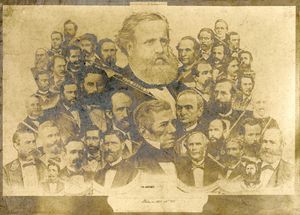
In foreign policy the Constitution required that the National Assembly be consulted about delarations of war, treaties and the conduct of international relations under Article 102. A determined legislator could exploit these Constitutional provisions to block or limit government decisions, influence appointments and force reconsideration of policies.[6]
During its annual four-month sessions the Assembly conducted public debates. These were widely reported and formed a national forum for the expression of public concerns from all parts of the country. It was frequently a venue for expressing opposition to policies and airing grievances. Legislators enjoyed immunity from prosecution for speeches made from the floor and in the discharge of their offices. Only their own chambers within the Assembly could order the arrest of a member during his tenure. "With no actual responsibility for the actual conduct of affairs, the legislators were free to propose sweeping reforms, advocate ideal solutions, and denounce compromising and opportunistic conduct by the government."[6]
The emperor was tasked with ensuring national independence and stability. The Constitution (Article 101) gave him very few avenues for imposing his will upon the National Assembly. His main recourse was the right to dissolve or extend legislative sessions. In the Senate, an emperor's authority to nominate senators did not necessarily give him added influence since senators held their offices for life and were thus freed from government pressure once confirmed. On those occasions when the Chamber of Deputies was dissolved, new elections were required to be held immediately and the new Chamber seated. "This power was effective when held in reserve as a threat. It could not be employed repeatedly, nor would its use work to the emperor's advantage."[6] During the reign of Pedro I the Chamber of Deputies was never dissolved and legislative sessions were never extended or postponed.[7] Under Pedro II, the Chamber of Deputies was never dissolved at his initiative, and this only occurred at the request of the President of the Council of Ministers. There were eleven dissolutions during the period of his reign, and of these, ten occurred after consultation with the Council of State which was beyond what was required by the Constitution.[8]
A Constitutional balance of power existed between the National Assembly and the executive branch under the emperor. The legislature could not operate alone and the monarch could not force his will upon the Assembly. The system functioned smoothly only when both Assembly and emperor acted in a spirit of cooperation for the national good.[6]
A new element was added when the office of "President of the Council of Ministers" was officially created in 1847—although it had existed in practice since 1843. The president of the Council owed his position to both his party and to the emperor and these could sometimes come into conflict. Nabuco said "The President of the Council in Brazil was no Russian Chancellor, Sovereign's creature, nor an English Prime Minister, made only by the trust of the Commons: the delegation of the Crown was to him as necessary and important as the delegation of the Chamber, and, to exert with safety his functions, he had to dominate the caprice, the oscillations and ambitions of the Parliament, as well as to preserve always unalterable the favor, the good will of the emperor."[9]
Provincial and local government
Elections
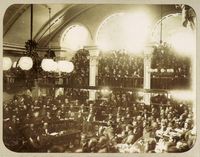
In Imperial Brazil voting was mandatory[10] and elections occurred in two steps. In the first phase voters chose Electors who then selected a slate of senatorial candidates. The emperor would choose a new Senator (member of the upper house) from a list of the three candidates who had received the highest number of votes. The Electors also chose the Deputies (members of the lower house), provincial deputies (members of the Provincial Assemblies) and councilmen (members of the town assemblies) without the involvement of the emperor in making a final selection.[11] All males 25 years of age or older with an income of at least Rs 100$000 (then the equivalent of $98.00 U.S.[12]) per year or more were eligible to vote in the first phase. The voting age was lowered to 21 for married men. To become an Elector it was necessary to have an annual income of at least Rs 200$000.[11]
The Brazilian system was quite democratic for the period during which indirect elections were common in democracies. The income requirement was much higher in the United Kingdom even after the 1832 reform.[13] At the time the only nations not requiring a certain level of income as a qualification for voting were France and Switzerland where universal suffrage was introduced only in 1848.[14][15] It is probable that no European country at the time had such liberal legislation as Brazil.[13] The income requirement was low enough that any employed male citizen could qualify to vote.[12][15] As an illustration the civil employee with the lowest wage in 1876 was a janitor working in the public sector who earned Rs 600$000 annually.[13]
Most voters in Brazil had a low income.[16][17] In 1876, for example, in the town of Formiga in the province of Minas Gerais the poor constituted 70% of the electorate and in Irajá in the province of Rio de Janeiro, they were 87%.[13][16][17] Ex-slaves could not vote, but their children and grandchildren could[14] as could the illiterate[18] (which few countries allowed).[16] In 1872 13% of the free Brazilian population voted.[19] For comparation in 1870 in the UK electoral participation was 7% of the total population; in Italy it was 2%; in Portugal 9%; and in the Netherlands 2.5%.[14] In 1832 the year of the British electoral reform 3% of the British voted. Further reforms in 1867 and 1884 expanded electoral participation in the UK to 15%.[20]
Although electoral fraud was common, it was not ignored by emperors, politicians or observers of the time. The problem was considered a major issue and attempts were made to correct abuses.[11][18] Legislation (including the electoral reforms of 1855, 1875 and 1881) was repeatedly enacted to attack fraud.[21] The 1881 reform brought significant changes, because it eliminated the two-part electoral system and introduced direct and facultative voting,[22] allowed the votes of former slaves and enfranchised non-Catholics.[17] There were negative effects as illiterate citizens were no longer allowed to vote.[17] And participation in elections dropped from 13% to only 0.8% in 1886.[17] In 1889 about 15% of the Brazilian population could read and write, so depriving the illiterate of the franchise is insufficient to explain the sudden fall in voting percentages. Because voting was no longer mandatory, this and lack of interest may have been significant factors contributing to the reduction in the number of voters.[23]
Armed Forces
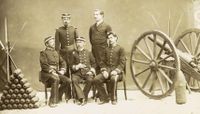
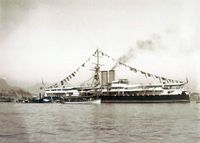
The Brazilian Armed Forces were subordinate to the Emperor, the Commander-in-Chief.[24] He was aided by the Ministers of War and Navy in regard to matters concerning the Army and the Armada respectively—although in practice the President of the Council of Ministers exercised oversight of both. Traditionally the Ministers of War and Navy were civilians though there were exceptions.[25][26]
The military was organized along lines similar to the 19th century British and American defense systems in which a small standing army could quickly augment its strength during emergencies from reserve militia (in Brazil, the National Guard) forces. Most important of all its first line of defense relied upon a powerful and large navy to protect the nation against foreign attack. As a matter of policy, the military was to be completely obedient to civilian governmental control and to keep at arms length from involvement in political decisions.[27]
Military personnel were allowed to run for and serve in political offices while remaining on active duty. However they did not represent the Army or the Armada but were expected instead to stand for the interests of the people in the city or province which had elected them.[25] Dom Pedro I chose nine military officers as Senators and appointed five (out of 14) to the Council of State. During the Regency, two were named to the Senate and none to the Council of State (this body was dormant while the Regency was in place). Dom Pedro II chose four officers as Senators during the 1840s, two in the 1850s and three others during the remaining years of his reign. He also appointed seven officers to be State Counselors during the 1840s–1850s and three after that.[28]
Foreign relations
Economy
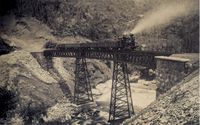
Currency
The unit of currency under the Empire and until 1942 was the real ("royal"), plural réis, and was derived from the Portuguese real. It was usually called milréis (English: thousand royals) and written as 1$000. A thousand milréis (1:000$000)—or one million réis—was known as conto de réis."[29] One conto de réis was represented by the symbol Rs written before the value and by a dollar sign separating the units group (lower than 1,000 réis). Thus, 350 réis was written as "Rs 350"; 1,712 réis as "Rs 1$712"; and 1,020,800 réis was written as "Rs 1:020$800". This means that the colon functioned as the millions comma and the $ sign as the thousands comma; the colon is the actual group separator and the $ sign is used only for separating the smaller group of units.[30]
Overview
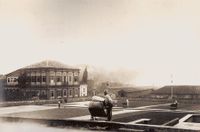
Brazil's international trade reached a total value of Rs 79.000:000$000 between 1834 and 1839. This continued to increase every year until it reached Rs 472.000:000$000 between 1886 and 1887: an annual growth rate of 3.88% since 1839.[31] The absolute value of exports from the Empire in 1850 was the highest in Latin America and triple that of Argentina which was in fourth place. Brazil would keep its high standing in exports and general economic growth until the end of the monarchy.[32] Brazilian economic expansion, especially after 1850, compared well with that of the United States and European nations.[33] The national revenue amounted to Rs 11.795:000$000 in 1831 and rose to Rs 160.840:000$000 in 1889. By 1858 it was the eighth largest in the world.[34] To give an idea of the economic potential of the country during the Empire the Barsa Encyclopedia calculated that "[if] it had been able to sustain the level of productivity achieved in 1780 and managed to increase exports at a pace equal to that verified in the second half of 19th century, its per capita income in 1950 would be comparable to the average per capita income of the Western European nations".[35]
As the decades passed, new technologies appeared. And with increases in internal productivity, exports increased considerably. This made it possible to reach equilibrium in the balance of trade. During the 1820s sugar constituted about 30% of total exports while cotton constituted 21%, coffee 18% and leather and skins 14%. Twenty years later coffee would reach 42%, sugar 27%, leather and skins 9%, and cotton 8% of the total exports. This did not mean a reduction in the production of these any of these items and, in fact, the opposite occurred. Growth occurred in all sectors, some more than others. In this period of only twenty years, Fausto says "Brazilian exports had doubled in volume and had tripled in nominal value" while the valuation denominated in Pounds sterling increased by over 40%.[36]
In the 1820s Brazil exported 11,000 tons of cacao and by 1880 this had increased to 73,500 tons.[37] Between 1821 and 1825 41,174 tons of sugar were exported which reached the incredible level of 238,074 tons between 1881 and 1885.[38] Up to 1850 rubber production was insignificant but between 1881 and 1890 it reached third place among Brazilian exports.[39] This was about 81 tons between 1827 and 1830 reaching 1,632 tons in 1852. By 1900 the country was exporting 24,301,452 tons of rubber.[37] Brazil also exported around 3,377,000 tons of coffee between 1821 and 1860 while between 1861 and 1889 this reached 6,804,000 tons.[40] Technological innovation also contributed to the growth of exports.[41] The main reason for this was the adoption of steam navigation and railroads which allowed transportation of cargo to become much easier and faster.[42]
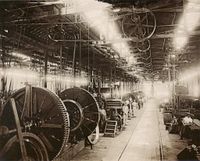
Development on an immense scale occurred during this period which anticipated similar advancements in European countries.[43][44] In 1850 there were 50 factories valued at more than Rs 7.000:000$000. At the end of the Imperial period in 1889 Brazil had 636 factories representing an annual rate of increase of 6.74% from 1850 and valued at approximately Rs 401.630:600$000 with an annual growth rate of 10.94% since 1850.[45] The "countryside echoed with the clang of iron track being laid as railroads were constructed at the most furious pace of the nineteenth century; indeed, building in the 1880's was the second greatest in absolute terms in Brazil's entire history. Only eight countries in the entire world laid more track in the decade than Brazil."[46] The first railroad line, with only 15 kilometers, was opened on 30 April 1854[47] at a time when many European countries had no rail service.[43] By 1868 there were 718 kilometers of railroad lines,[48] and by the end of the Empire in 1889 this had grown to 9,200 kilometers with another 9,000 kilometers under construction[49] making it the country with "the largest rail network in Latin America".[46]
Factories were constructed throughout the Empire during the 1880s allowing Brazil's cities began to be modernized and "receive the benefits of gas, electrical, sanitation, telegraph and tram companies. Brazil was entering the modern world."[46] It was the fifth country in the world to install modern city sewers, the third to have sewage treatment[43] and one of the pioneers in the installation of a telephone service.[50] Beyond these it was the first South American nation to adopt public electric illumination (in 1883)[51] and the second in the Americas (behind the United States) to estabilish a transatlantic telegraphic line connecting it directly to Europe in 1874.[43] The first domestic telegraph line appeared in 1852 in Rio de Janeiro. By 1889 there were 18,925 kilometers of telegraph lines connecting the country's capital to distant Brazilian provinces such as Pará and even linking to other South American countries such as Argentina and Uruguay.[52]
Society
Demographics
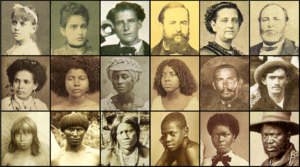
Ever since the second half of the 18th century, even when Brazil was still a colony, the government attempted to gather data regarding the population. However, few captaincies (later called provinces) collected the requested information.[53] After independence the government instituted a commission for statistics in a decree of 1829 with a mandate to hold a national census.[53] The commission was a failure and was disbanded in 1834. In the ensuing years provincial governments were tasked with collecting census information but their census reports were often incomplete or not done at all.[53] In 1851 another try at a nationwide census ended in failure due to rioting by Brazilians of mixed-race descent who believed (erroneously) that the survey was a subterfuge with the purpose of enslaving anyone having African blood.[54]
The first true national census with exhaustive and broad coverage was done in 1872. It showed Brazil as having a total population of 9,930,478 inhabitants.[54] Estimates made by the government in prior decades showed 4,000,000 inhabitants in 1823 and gave a figure of 7,000,700 in 1854.[54] The population was distributed across 20 provinces and one neutral district (the Imperial capital) with 641 municipalities and 1,473 smaller towns.[54] The small population and small number of towns revealed an enormous but sparsely populated country.
Among the free population 23.4% of males and 13.4% of females were considered literate.[55] Men represented 52% (5,123,869) of the total population.[55] Figures for the population by age showed: 24.6% were children between the ages of 0 and 10; 21.1% were adolescents and young men between 11 and 20; 32.9% were adults between 21 and 40; 8.4% were between 41 and 50; 12.8% were between 51 and 70; and lastly, only 3.4% were over 71.[55] The northeast region and the southeast region together held 87.2% of the total population.[56]
The second national census was held in 1890 when the Brazilian republic was but a few months old. Its results showed that the population had grown in the meantime to 14,333,915 inhabitants.[57]
Ethnic groups
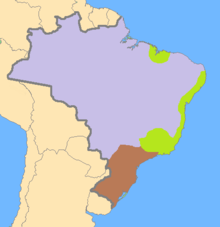
In Imperial Brazil the ethnic groups recognized were: white, black, Indian and pardo.[57] The pardo (English: Brown) was a designation for multiracial Brazilians which is still officially used[58][59] though some scholars prefer the term mestiço (English: Mixed one). The term denotes a broad category which includes caboclos (descendants of Whites and Indians), mulattoes (descendants of Whites and Blacks) and cafusos (descendants of Blacks and Indians).[58][59][60][61][62][63][64]
The caboclos formed the majority of the population in the Northern, Northeastern and Central-Western regions.[55][65] A large mulatto population inhabited the eastern coast of the northeastern region from Bahia to Paraíba[64][66] and were also present in northern Maranhão,[67][68] southern Minas Gerais,[69] eastern Rio de Janeiro and in Espírito Santo.[64][69] The cafuso were the smallest and most difficult to distinguish from the two other mixed-race subgroups since the descendants of caboclos and mulattoes interbreeding also fall into this category and were found in the northeast sertão (English: backcountry). These groups may still be found in the same areas today.[70]
The white Brazilians descended from the original Portuguese settlers. From the 1870s on these also included other European immigrants: mainly Italians, Spanish and Germans. Although they could be found throughout the country they were the majority group in the southern region and in São Paulo province.[55] Whites also comprised a significant proportion (40%) of the population in the northeastern provinces of Ceará, Paraíba and Rio Grande do Norte.[55] The black Brazilians of Sub-Saharan African ancestry inhabited the same areas as mulattoes. The majority of the population of Rio de Janeiro, Minas Gerais, Espírito Santo, Bahia, Sergipe, Alagoas and Pernambuco provinces (the last four having the smallest percentages of whites in the entire nation—less than 30% in each) were black or pardo.[55] The Indians, the indigenous peoples of Brazil, were found mainly in Piauí, Maranhão, Pará and Amazonas.[55]
Because of the existence of distinct racial and cultural communities, 19th Century Brazil developed as a multi–ethnic nation. However the data is problematic as no reliable information is available for the years prior to 1872. Historian Afrânio Peixoto reported that the population of 1835 was made up of 24.1% whites, 18.2% pardos, 51.4% blacks and an unknown number of Indians. In 1872 there were 38.1% whites, 38.4% pardos, 16.5% blacks and 7% Indians. By 1890 the figures were 44% whites, 32% pardos, 12% blacks and 12% Indians.[71] The main issue regarding this data is that the author does not say what sources were used in obtaining the statistics.[71]
| Ethnic groups in Brazil (1872 and 1890) | |||||||
| Years | Whites | Pardos | Blacks | Indians | Total | ||
|---|---|---|---|---|---|---|---|
| 1872 | 38.1% | 38.3% | 19.7% | 3.9% | 100% | ||
| 1890 | 44.0% | 32.4% | 14.6% | 9% | 100% | ||
An unofficial estimate made by the explorer Alexander von Humboldt in 1825 reveals a nation with 920,000 whites, 1,960,000 blacks and 1,120,000 pardos and Indians out of a total population of 4 million inhabitants in that year.[57] A rough calculation made by another person in 1830 argued that there were 71.3% whites and caboclos and 28.9% blacks but did not detail which group included the descendants of white and black miscegenation.[57] The traveler Johann Moritz Rugendas believed that in 1835 there were 854,000 whites, 648,000 pardos and 1,987,000 blacks.[57]
The first official national census was compiled by the government in 1872 showing that out of 9,930,479 inhabitants there were 38.1% whites, 38.3% pardos, 19.7% blacks and 3.9% Indians.[57] The second official national census in 1890 revealed that in a population of 14,333,915, 44% were whites, 32.4% pardos, 14.6% blacks and 9% Indians.[57]
European immigration
Slavery


In 1823, barely a year after it became an independent nation, slaves represented 29% of the population in Brazil. This percentage fell as time passed: from 24% in 1854, to 15.2% in 1872 and finally to less than 5% in 1887—the year before slavery was completely abolished.[72] Slaves were mostly adult males from southwestern Africa.[73] Slaves brought to Brazil differed ethnically, religiously and in language. They identified with their own nations rather than as Africans.[74] African tribes fought among themselves and some of the slaves acquired in successful wars were sold to slave dealers who brought them to the Americas.[75][76] While slaves were usually black or mulatto there were reported cases of white slaves—albeit very rare and generally disapproved socially—the product of generations of interbreeding between male slave owners and their female mulatto slaves.[77] Slaves and their descendants were usually found in regions devoted to producing exports for foreign markets.[78] The eastern coast of the northwest region is representative where, during the 16th to 17th century, sugarcane was an important export crop.[79] Northern Maranhão province is another instance where cotton and rice were produced in the 18th century.[80] Also in the same century slaves were used in the Minas Gerais province where gold was extracted.[81] Slavery was also common in Rio de Janeiro, São Paulo, Espírito Santo and again in Minas Gerais during the 19th century for the cultivation of coffee which became vital to the national economy.
Most slaves worked as plantation laborers.[82] Relatively few Brazilians owned slaves and medium and small farms usually employed free workers.[83]. Slaves could be found scattered throughout society in other capacities: some were used as house servants, farmers, miners, prostitutes, gardeners and in many other jobs.[84] Many emancipated slaves went on to acquire slaves and there were even cases of slaves who had their own slaves.[85][86] Even the most harsh slave owners adhered to a long-established practice of selling slaves along with their families taking care not to separate individuals.[87]
The prevalence of slavery was not uniform geographically across Brazil. Around 1870 only five provinces (Rio de Janeiro with 30%, Bahia with 15%, Minas Gerais with 14%, São Paulo with 7% and Rio Grande do Sul also with 7%) held 73% of the nation's total slave population.[82] These were followed by Pernambuco (with 6%) and Alagoas (with 4%). Among the remaining 13 provinces none individually had even 3%.[88] It should also be noted that slaves who were freed instantly became citizens with all civil rights guaranteed with the exception that freed slaves were barred from voting in elections though their children and descendants could vote.[14]
Nobility
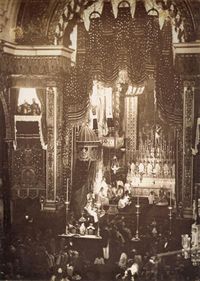
The nobility of Brazil differed markedly from counterparts in Europe. Noble titles were not hereditary with sole exception of members of the Imperial Family.[89] Persons who had received a noble title were not considered as belonging to a separate social class and received no appanages, stipends or emoluments.[89] Many ranks, traditions and regulations in Brazil's system of nobility were coopted directly from the Portuguese aristocracy.[90][91] During Pedro I's reign there were no clear requisites for someone to be ennobled. In Pedro II's reign (excepting the Regency period during which the Regent could not grant titles or honors[92]) the nobility evolved into a meritocracy[90] with titles granted to individuals in recognition of outstanding service to the Empire or to the public good. Noble rank did not represent "recognition of illustrious ancestry."[93][94]
It was the Emperor's right as head of the Executive branch to grant titles and honors.[90] The titles of nobility were, from lowest to highest: baron, viscount, count, marquis and duke.[90] Apart from position in the hierarchy there were other distinctions between the ranks: count, marquises and dukes were considered "Grandees of the Empire" while the titles of barons and viscounts could be bestowed "with Greatness" or "without Greatness".[90] All of them were to be addressed as "Your Excellency".[90]
From 1822 until 1889, 986 people were ennobled.[95] Only three became Dukes: Auguste de Beauharnais, 2nd Duke of Leuchtenberg (as Duke of Santa Cruz, brother-in-law to Pedro I), Dona Isabel Maria de Alcântara Brasileira (as Duchess of Goiás, illegitimate daughter of Pedro I) and lastly Luís Alves de Lima e Silva (as Duke of Caxias, hero of the War of the Triple Alliance).[96] The other titles granted were: 47 marquises, 51 counts, 146 viscounts "with Greatness", 89 viscounts "without Greatness", 135 barons "with Greatness" and 740 barons "without greatness" resulting in a total of 1,211 noble titles.[97] The reason why there were fewer nobles than noble titles is because many were elevated more than once during their lifetime (e.g., the Duke of Caxias, who was baron, then count, marquis and then duke).[92] Grants of nobility did not include only Brazilians and men. There was the case of Thomas Cochrane, 10th Earl of Dundonald a Scot who was made Marquis of Maranhão for his role in the Brazilian War of Independence.[98] There were also 29 women who received grants of nobility in their own right.[99] As well as not being limited by gender, no racial distinctions were made in conferring noble status. Caboclos,[100] mulattoes,[101] blacks[102] and even Indians[103] were ennobled.
Members of the Imperial Orders constituted the lesser nobility (that is, non-titled nobles). There were six of these: the Order of Christ, the Order of Saint Benedict of Aviz, the Order of Saint James of the Sword, the Order of the Southern Cross, the Order of Pedro I and the Order of the Rose.[104] The first three had grades of honor beyond the Grand Master (reserved to the emperor only): knight, commander and grand cross. The latter three, however, had different ranks: the Order of the Southern Cross with four, and the Order of the Rose with no fewer than six.[104]
Religion
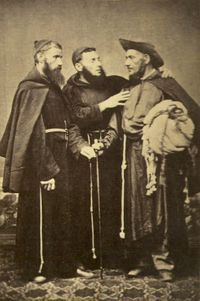
Article 5 of the Constitution declared Catholicism to be the state religion.[105] However, the clergy had long been understaffed, undisciplined and poorly educated.[106][107] This led to a general loss of respect for the Catholic Church.[106] In Pedro II's reign the Imperial government embarked upon a program of reform to address these deficiencies.[106] As the Catholic Church was the official religion, the Emperor exercised a great deal of control over Church affairs[106] and paid clerical salaries, appointed parish priests, nominated bishops, ratified papal bulls and supervised seminaries.[106][108] In pursuing reform the government selected bishops which satisfied its criteria for education, support for reform and moral fitness.[106][107] However, as more capable men began to fill the clerical ranks, resentment of government control over the Church increased.[106][107]
Catholic clerics moved closer to the Pope and his doctrines, mainly Ultramontanism. This resulted in clashes during the 1870s between the clergy and the government since the former desired a more direct relationship with Rome and the latter wished to maintain its oversight of church affairs. Only after arduous negotiations was the government able to restore good relations with the clergy but at a high price.[109] The main consequence was that the clergy no longer discerned any benefit in rendering their support to Pedro II.[110] Although they had abandoned the Emperor, they eagerly anticipated the day when his eldest daughter and heir Isabel would ascend the throne due to her ultramontane views.[111] At the same time, the Catholic Church began to perceive Positivisn as a serious threat—especially in Brazil where it had taken root among the Military corps by the end of the monarchy. Positivist doctrine embodied a clear anti-religious stance.[112]
The Constitution did allow the existence of other religious faiths although these were restricted to private practices and their religious buildings were forbidden.[113] From the outset these restrictions were ignored and the authorities never bothered to interfere. The main non-Catholic faiths in Brazil, although a very small minority, were Judaism and Protestantism.
All Jews residing in Portugal were forcibly converted to Catholicism in 1496 years before Brazil was claimed by the Portuguese Crown.[113] Those who resisted were expelled and later settled in northern Africa (mainly in Morroco). These became known as Sephardi Jews.[113] Their descendants, who curiously still spoke Portuguese after centuries, migrated to Brazil soon after its independence and settled mainly in the northeastern provinces of Bahia and Pernambuco and in the northern provinces of Amazonas and Pará.[113] In Belém, Para's capital, the first synagogue was built in 1824—the same year in which Brazil's Constitution was promulgated.[113] Other Jewish groups came from Germany (more precisely Alsace-Lorraine) and Ashkenazi Jews immigrated from Russia to escape the anti-semitic pogroms following the assassination of Czar Alexander II in 1881.[114] By the 1880s there were several Jewish communities and synagogues scattered throughout Brazil.[115]
The Protestants were another group that began settling in Brazil at the beginning of the 19th Century. The first Protestants were English who opened an Anglican church in Rio de Janeiro in 1820. Others were established afterwards in São Paulo, Pernambuco and Bahia provinces.[116] They were followed by Lutheran Germans and Swiss who settled in the South and Southwest regions and built their own houses of worship.[116] Decades later in the 1860s immigrants from the southern United States settled in São Paulo after fleeing the Reconstruction policy following the end of the U.S. Civil War. There followed various mission activities sponsored by several American churches including Baptists, Lutherans, Congregationalists and the Methodists who were most active of all.[117] In addition to preaching they also built churches, started schools and published newspapers which were warmly welcomed by Brazilians.[112]
See also
- Monarchies in the Americas
Bibliography
Footnotes
- ↑ Olivieri (1999), p. 50.
- ↑ Schwarcz (1998), p. 457.
- ↑ Besouchet (1993), p. 505.
- ↑ Barman (1988), p. 132.
- ↑ Barman (1988), pp. 132–133.
- ↑ 6.0 6.1 6.2 6.3 Barman (1988), p. 133.
- ↑ Vianna (1994), p. 476.
- ↑ Carvalho (1993), p. 42.
- ↑ Nabuco (1975), p. 712.
- ↑ Carvalho (2008), p. 29.
- ↑ 11.0 11.1 11.2 Vainfas (2002), p. 223.
- ↑ 12.0 12.1 Barman (1988), p. 124.
- ↑ 13.0 13.1 13.2 13.3 Carvalho (2008), p. 30.
- ↑ 14.0 14.1 14.2 14.3 Vainfas (2002), p. 139.
- ↑ 15.0 15.1 Carvalho (2008), p. 31.
- ↑ 16.0 16.1 16.2 Carvalho (1993), p. 46.
- ↑ 17.0 17.1 17.2 17.3 17.4 Vainfas (2002), p. 224.
- ↑ 18.0 18.1 Carvalho (2007), p. 180.
- ↑ Carvalho (1993), p. 48.
- ↑ Carvalho (2008), p. 39.
- ↑ Carvalho (2008), p. 33.
- ↑ Carvalho (1993), p. 51.
- ↑ Carvalho (1987), p. 91.
- ↑ See Articles 102 and 148 of the Brazilian Constitution of 1824
- ↑ 25.0 25.1 Carvalho (2007), p. 193.
- ↑ Lyra (v.3 1977), p. 84.
- ↑ Pedrosa, p.289
- ↑ Holanda (1974), pp. 241–242.
- ↑ Barman (1999), p. XVI.
- ↑ Graça Filho, p. 21.
- ↑ Sodré (2004), p. 201.
- ↑ Fausto (2005), p. 47.
- ↑ Fausto (2005), p. 50.
- ↑ Lyra (v.1, 1977), p. 200.
- ↑ Enciclopédia Barsa (1987), v. 4, p. 270.
- ↑ Fausto (2005), p. 46.
- ↑ 37.0 37.1 Vainfas (2002), p. 250.
- ↑ Vainfas (2002), p. 251.
- ↑ Fausto (1995), p. 239
- ↑ Calmon (2002), p. 368.
- ↑ Fausto (2005), p. 46
- ↑ Vainfas (2002), p. 538.
- ↑ 43.0 43.1 43.2 43.3 Lyra (v.2, 1977), p. 13.
- ↑ Vasquez (2007), p. 38.
- ↑ Vianna (1994), p. 496.
- ↑ 46.0 46.1 46.2 Topik (1996), p. 56.
- ↑ Calmon (2002), p. 222.
- ↑ Calmon (2002), p. 225.
- ↑ Calmon (2002), p. 226.
- ↑ Lyra (v.2, 1977), p. 309.
- ↑ Vainfas (2002), p. 539.
- ↑ Calmon (2002), p. 366.
- ↑ 53.0 53.1 53.2 Vainfas (2002), p. 131.
- ↑ 54.0 54.1 54.2 54.3 Vainfas (2002), p. 132.
- ↑ 55.0 55.1 55.2 55.3 55.4 55.5 55.6 55.7 Vainfas (2002), p. 133.
- ↑ Baer (2002), p. 341.
- ↑ 57.0 57.1 57.2 57.3 57.4 57.5 57.6 Ramos (2003), p. 82.
- ↑ 58.0 58.1 Coelho (1996), p. 268.
- ↑ 59.0 59.1 Vesentini (1988), p. 117.
- ↑ Ramos (2003), p. 65.
- ↑ Enciclopédia Barsa (1987), v. 4, p. 230.
- ↑ Adas (2004), p. 268.
- ↑ Azevedo (1971), pp. 2–3.
- ↑ 64.0 64.1 64.2 Moreira (1981), p. 108.
- ↑ Enciclopédia Barsa (1987), v. 4, p. 254–55, 258, 265.
- ↑ Azevedo (1971), pp. 74–75.
- ↑ Enciclopédia Barsa (1987), v. 10, p. 355.
- ↑ Azevedo (1971), p. 74.
- ↑ 69.0 69.1 Azevedo (1971), p. 161.
- ↑ Ramos (2003), p. 84,
- ↑ 71.0 71.1 Ramos (2003), p. 81.
- ↑ Vainfas (2002), pp. 18, 239.
- ↑ Vainfas (2002), pp. 237–238.
- ↑ Vainfas (2002), p. 29.
- ↑ Boxer (2002), pp. 113–114, 116.
- ↑ Vainfas (2002), p. 30.
- ↑ Alencastro (1997), pp. 87–88.
- ↑ Boxer (2002), pp. 185–186.
- ↑ Boxer (2002), p. 117.
- ↑ Boxer (2002), p. 206.
- ↑ Boxer (2002), p. 169.
- ↑ 82.0 82.1 Vainfas (2002), p. 239.
- ↑ Fausto (1995), p. 238–239.
- ↑ Olivieri (1999), p. 43.
- ↑ Barman (1988), p. 194.
- ↑ Carvalho (2007), p. 130.
- ↑ Besouchet (1985), p. 170.
- ↑ Besouchet (1985), p. 167.
- ↑ 89.0 89.1 Vainfas (2002), p. 553.
- ↑ 90.0 90.1 90.2 90.3 90.4 90.5 Vainfas (2002), p. 554.
- ↑ Barman (1999), p. 11.
- ↑ 92.0 92.1 Vianna (1968), p. 208.
- ↑ Barman (1999), p. 139.
- ↑ Vianna (1968), p. 220.
- ↑ Vianna (1968), p. 216.
- ↑ Vianna (1968), pp. 204, 206.
- ↑ Vianna (1968), p. 218.
- ↑ Vianna (1968), p. 219.
- ↑ Vianna (1968), p. 221.
- ↑ e.g., Aureliano de Sousa e Oliveira Coutinho, Viscount of Sepetiba —Barman (1999), p. 77.
- ↑ e.g., Francisco Gê Acaiba de Montezuma, Viscount of Jequitinhonha —Vianna (1968), p. 217.
- ↑ e.g., the Baron of Tijuca —Schwarcz (1998), p. 191.
- ↑ e.g., the Baron of Guapi —Schwarcz (1998), p. 191.
- ↑ 104.0 104.1 Barman (1999), p. 11.
- ↑ Vainfas (2002), p. 126.
- ↑ 106.0 106.1 106.2 106.3 106.4 106.5 106.6 Barman (1999), p. 254.
- ↑ 107.0 107.1 107.2 Carvalho (2007), p. 151.
- ↑ Carvalho (2007), p. 150.
- ↑ Barman (1999), pp. 254–256.
- ↑ Carvalho (2007), p. 153.
- ↑ Carvalho (2007), p. 155.
- ↑ 112.0 112.1 Vainfas (2002), p. 597.
- ↑ 113.0 113.1 113.2 113.3 113.4 Vainfas (2002), p. 450.
- ↑ Vainfas (2002), pp. 450–451.
- ↑ Vainfas (2002), p. 451.
- ↑ 116.0 116.1 Vainfas (2002), p. 596.
- ↑ Vainfas (2002), pp. 596–597.
References
- Adas, Melhem. 2004. Panorama geográfico do Brasil, 4th ed. São Paulo: Moderna.
- Alencastro, Luiz Felipe de. 1997. História da vida privada no Brasil: Império. São Paulo: Companhia das Letras. ISBN 9788571646810
- Azevedo, Aroldo. 1971. O Brasil e suas regiões. São Paulo: Companhia Editora Nacional. (Portuguese)
- Baer, Werner. 2002. A Economia Brasileira, 2nd ed. São Paulo: Nobel. ISBN 9788521311973
- Barman, Roderick J. 1988. Brazil: The Forging of a Nation, 1798–1852. Stanford: Stanford University Press. ISBN 0804714371
- Barman, Roderick J. 1999. Citizen Emperor: Pedro II and the Making of Brazil, 1825–1891. Stanford: Stanford University Press. ISBN 1804735107 (English)
- Besouchet, Lidia. 1985. José Maria Paranhos: Visconde do Rio Branco: ensaio histórico-biográfico. Rio de Janeiro: Nova Fronteira. (Portuguese)
- Besouchet, Lídia. 1993. Pedro II e o Século XIX. 2. ed. Rio de Janeiro: Nova Fronteira. ISBN 85-209-0494-7 (Portuguese)
- Boxer, Charles R.. 2002. O império marítimo português 1415–1825. São Paulo: Companhia das Letras. ISBN 8535902929 (Portuguese)
- Calmon, Pedro. 2002. História da Civilização Brasileira. Brasília: Senado Federal. (Portuguese)
- Carvalho, José Murilo de. 1987. Os Bestializados: o Rio de Janeiro e a República que não foi. 2. ed. São Paulo: Companhia das Letras. (Portuguese)
- Carvalho, José Murilo de. 1993. A Monarquia brasileira. Rio de Janeiro: Ao Livro Técnico. (Portuguese)
- Carvalho, José Murilo de. 2007. D. Pedro II: ser ou não ser. São Paulo: Companhia das Letras. ISBN 9788535909692 (Portuguese)
- Carvalho, José Murilo de. 2008. Cidadania no Brasil: o longo caminho. 10. ed. Rio de Janeiro: Civilização Brasileira. (Portuguese)
- Coelho, Marcos Amorim. 1996. Geografia do Brasil. 4th ed. São Paulo: Moderna. (Portuguese)
- Holanda, Sérgio Buarque de. 1974. História Geral da Civilização Brasileira: Declínio e Queda do Império (2a. ed.). São Paulo: Difusão Européia do Livro. (Portuguese)
- 1987. Enciclopédia Barsa. Rio de Janeiro: Encyclopædia Britannica do Brasil. (Portuguese)
- Fausto, Boris and Devoto, Fernando J. 2005. Brasil e Argentina: Um ensaio de história comparada (1850–2002), 2. ed. São Paulo: Editoria 34. (Portuguese)
- Lyra, Heitor. 1977. História de Dom Pedro II (1825–1891): Ascenção (1825–1870). v.1. Belo Horizonte: Itatiaia. (Portuguese)
- Lyra, Heitor. 1977. História de Dom Pedro II (1825–1891): Fastígio (1870–1880). v.2. Belo Horizonte: Itatiaia. (Portuguese)
- Lyra, Heitor. 1977. História de Dom Pedro II (1825–1891): Declínio (1880–1891). v.3. Belo Horizonte: Itatiaia. (Portuguese)
- Moreira, Igor A. G. 1981. O Espaço Geográfico, geografia geral e do Brasil. 18. Ed. São Paulo: Ática. (Portuguese)
- Nabuco, Joaquim. 1975. Um Estadista do Império. Volume único. 4th ed. Rio de Janeiro: Nova Aguilar. (Portuguese)
- Olivieri, Antonio Carlos. 1999. Dom Pedro II, Imperador do Brasil. São Paulo: Callis. (Portuguese)
- Pedrosa, J. F. Maya. 2004. A Catástrofe dos Erros: razões e emoções na guerra contra o Paraguai. Rio de Janeiro: Biblioteca do Exército. ISBN 8570113528 (Portuguese)
- Ramos, Arthur. 2003. A mestiçagem no Brasil. Maceió: EDUFAL. ISBN 8571771812 (Portuguese)
- Schwarcz, Lilia Moritz. 1998. As barbas do Imperador: D. Pedro II, um monarca nos trópicos. 2. Ed. São Paulo: Companhia das Letras. ISBN 8571648379 (Portuguese)
- Vainfas, Ronaldo. 2002. Dicionário do Brasil Imperial. Rio de Janeiro: Objetiva. ISBN 8573024410 (Portuguese)
- Vesentini, José William. 1988. Brasil, sociedade e espaço – Geografia do Brasil. 7th Ed. São Paulo: Ática. (Portuguese)
- Vianna, Hélio. 1968. Vultos do Império. São Paulo: Companhia Editora Nacional. (Portuguese)
- Vianna, Hélio. 1994. História do Brasil: período colonial, monarquia e república, 15. ed. São Paulo: Melhoramentos. ISBN 1000109936421 (Portuguese)
|
||||||||||||||||||||
|
||||||||||||||||||||||||||||||||||||||


.svg.png)